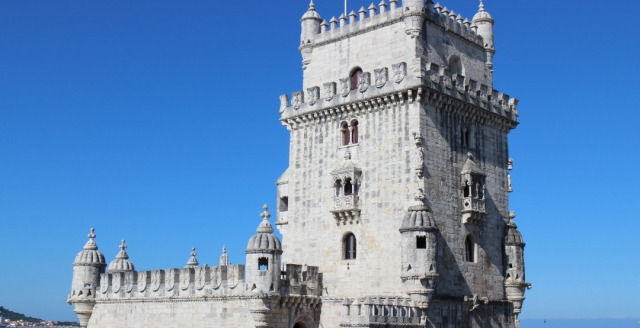Torre de Belém
An emblem of the city of Lisbon
Located in Lisbon, the Belém Tower is one of the most emblematic and photographed monuments in the city. An authentic icon that attracts thousands of tourists year after year thanks to its imposing Manueline architecture, and a true symbol of the Age of Discoveries. In the same way as in previous points of interest, we are going to break down the place from its history and context, through its architecture, uses, decoration or how to access them today.
Let's start with the highlight, the construction of the Belém Tower. The building rose in the 16th century, specifically between the years 1514 and 1520, during the reign of Manuel I of Portugal. Its objective was none other than to serve as a defense point at the entrance to the port of Lisbon, thus as a lighthouse to guide the different sailors who entered the high seas. As we have already mentioned, the construction of the Belém Tower coincides with the Age of Discoveries; moment when Portugal expanded its maritime borders and established important trade routes through Africa, Asia and Brazil. Once its construction was completed, it went It became an imposing prison, also offering military use for the army.
Gothic, Renaissance and Moorish styles go hand in hand in its architecture
We have previously mentioned that the Torre de Belém is one of the most iconic buildings within the Manueline style, and it is no wonder. We are talking about a construction in which Gothic, Renaissance and Moorish styles and elements fit together like a glove, especially highlighting its intricate ornaments, where ropes sculpted in stone, shields, armillary spheres and other marine elements stand out. p>
A detail to keep in mind is that originally the tower was built in the center of the Tagus River, but did you know that over the years the construction has been moved? This is because with the course of the river in the first centuries they were “transporting” The tower was moved to its current location near the shore.
Composed of five floors in its tower and a bastion, the decoration of the construction includes all types of nautical and religious motifs, thus reflecting the the spirit of the age of discoveries and the Christian evolution that Portugal has gone through. Being one of the symbols of the country, the Belém Tower became a symbol of the country. In 1983 it was declared a UNESCO World Heritage Site, in addition to the Jerónimos Monastery, due to its cultural and architectural significance. A building that reflects the historical wealth of the country and its pioneering role in global maritime exploration.
With this history, it is not surprising that the building became one of the main tourist attractions. Visitors from all over the world come to admire its architectural beauty, the rich history of the place and the stunning views of the Tagus River. As a tourist you will be able to explore some of the most popular areas of the tower such as the old cells when the place became a prison. in prison, the terrace with its impressive panoramic views or the weapons room.
Visiting hours
From October to April: from 10:00 a.m. to 5:30 p.m.
From May to September: from 10:00 a.m. to 6:30 p.m.
Closed: every Monday, January 1, Easter Sunday, May 1 and December 25.
21°
27/07/2024
few clouds

- Connection by bus
- Cash machine
- Pharmacies
- Connection by train
- Supermarkets
- Taxi stops
Routes
Blog
 How to get to Sarria to do the Camino de Santiago
How to get to Sarria to do the Camino de Santiago
 Descubre la magia del Camino de Santiago Portugués por la costa
Descubre la magia del Camino de Santiago Portugués por la costa
 5 tours culturales que puedes hacer en Galicia si decides hacer un alto en el camino
5 tours culturales que puedes hacer en Galicia si decides hacer un alto en el camino
 Doing the Camino de Santiago in June: What you should know?
Doing the Camino de Santiago in June: What you should know?
Information
Points of interest
Cities & Towns | Hostels | Lodgings | Restaurants | Saddlery | Doctors | Points of interest | Bikes workshop
Contact us | Privacy policy | Cookies policy | | Terms of use | Authorship | Web Map | Consentimiento
© Copyright LA VOZ DE GALICIA S.A. Polígono de Sabón, Arteixo, A CORUÑA (ESPAÑA) Inscrita en el Registro Mercantil de A Coruña en el Tomo 2438 del Archivo, Sección General, a los folios 91 y siguientes, hoja C-2141. CIF: A-15000649
Developed and managed byHyliacom

 Redacción
Redacción